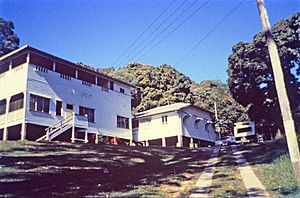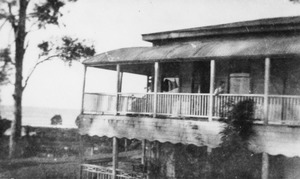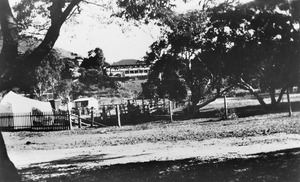Halse Lodge facts for kids
Quick facts for kids Halse Lodge |
|
|---|---|

Halse Lodge, before 1988
|
|
| Location | 17 Noosa Drive, Noosa Heads, Shire of Noosa, Queensland, Australia |
| Design period | 1870s - 1890s (late 19th century) |
| Built | 1880s - 1920s |
| Official name: Halse Lodge, Bay View, Hillcrest Guest House | |
| Type | state heritage (built) |
| Designated | 30 April 1997 |
| Reference no. | 601393 |
| Significant period | 1880s-1920s (fabric) 1880s-1950s (historical) 1920s - (social) |
| Significant components | driveway, trellis, service wing, residential accommodation - guest house/s, residential accommodation - caretaker's quarters, amenities building, terracing, conference/activities centre, views to, natural landscape, views from, courtyard |
| Lua error in Module:Location_map at line 420: attempt to index field 'wikibase' (a nil value). | |
Halse Lodge is a special old guest house located at 17 Noosa Drive in Noosa Heads, Queensland, Australia. It was built between the 1880s and the 1920s. This historic building has also been known as Bay View and Hillcrest Guest House. It is so important that it was added to the Queensland Heritage Register on April 30, 1997.
Contents
The Story of Halse Lodge
Halse Lodge has a long and interesting history. It has been a place for people to stay since the early 1880s! It was first called Bayview, then Hillcrest Guest House. It was largely rebuilt in the 1920s. Halse Lodge is the only guest house from the 1920s still standing in Noosa Heads. It's also one of the few places in southeast Queensland that has been a seaside guest house for such a long time.
Early Days and Walter Hay
The land where Bayview was built was first owned by James Forsyth in 1871. Later, in 1881, the land was transferred to Walter Hay. Walter Hay was very important in the early development of the Noosa area. He helped find a route from Gympie to the Noosa River. This helped the town of Noosa grow.
By the 1880s, Walter Hay owned a lot of land in the area. In 1882, he advertised Bay View for rent. It was described as a house with 10 rooms on five acres of land. It was located on the South Head, near the mouth of the Noosa River.
Growing as a Guest House
During the 1890s, Bayview was rented out to different people. It was slowly made bigger over time. By 1900, it was one of only two guest houses in Noosa. Photos from that time show it as a two-story timber building. It also had a separate building at the back. This is likely the start of the building we see today.
The property changed owners a few times in the early 1900s. In 1918, John Donovan bought it.
Becoming Hillcrest Guest House
Bayview was greatly rebuilt and made larger in the 1920s. After this, it became known as Hillcrest Guest House. The property was also divided into smaller pieces of land in 1925.
Noosa became more and more popular as a holiday spot in the early 1900s. This growth really picked up in the 1920s. More cafes and places to stay were built along Hastings Street. More people owned cars, and they had more free time. This meant places like Noosa became very popular for holidays. A guest book from Hillcrest in 1944 shows that visitors came from all over. They came from Brisbane, other parts of Queensland, and even other countries! Many guests loved the place so much they wrote poems or drew pictures in the book.
Halse Lodge Today
In 1959, the Anglican Church bought Hillcrest Guest House. They renamed it Halse Lodge, after Archbishop Reginald Halse. At this time, the property was just over two acres. From 1959 to 1988, not many changes were made to the building. It was mainly used for groups, fitting up to 80 people.
In 1988, Halse Lodge had some big renovations. New parts were added, like a front entrance and a kitchen. Some old parts were taken down and new ones built. The building was also updated in other ways. Today, Halse Lodge still operates as a guest house. It can host about 60 people.
The town's name changed from Noosa to Noosa Heads in 1988. As Noosa Heads grew as a tourist area, many old timber guest houses were taken down. Halse Lodge is special because it has survived.
What Halse Lodge Looks Like
Halse Lodge is a two-story timber building. It has a hipped roof made of corrugated iron. It sits on a hill, looking out over Noosa, the Noosa River, and Laguna Bay. You reach the building by a long driveway from Noosa Drive.
The building is shaped like a "U". It has a courtyard facing south. On one side is a two-story wing for guests. On another side is a single-story wing for the caretaker. On the third side is a two-story wing with bathrooms. These three parts are connected by open verandahs on the ground floor. The building stands on concrete stumps with timber panels.
The guest accommodation wing has verandahs on two sides. The ground floor verandah has a timber fence-like railing. It has timber posts and shaped wooden supports. The walls are made of timber boards. There are French doors with windows above them. The first floor verandah has a timber railing with open panels. It has timber posts and open ceilings. The French doors also have timber panels above them.
Inside, the ground floor has a large dining room. There are also smaller rooms that open onto the verandah. The walls are made of vertical timber boards. The first floor has a hallway with bedrooms on both sides.
The single-story caretaker's wing has timber board walls. It has a large metal vent on the roof. It also has windows with timber and corrugated iron covers. Inside, it has bedrooms, a bathroom, an office, a small kitchen, and a living area.
The two-story amenities wing has timber board walls and windows. Inside, it has a laundry room on the ground floor. There are bathrooms on both the ground and first floors.
There is also a separate building called an activity centre. It has a hipped corrugated iron roof. It is made of timber boards and has windows. It also has a verandah.
Around the building, there are old trees. This includes a large eucalypt tree near the driveway. There is also a mango tree. The driveway area is terraced, meaning it has flat levels. The ground slopes steeply down to a gully and creek.
Why Halse Lodge is Important
Halse Lodge was listed on the Queensland Heritage Register in 1997. This means it is a very important historical place.
Showing Queensland's History
Halse Lodge was largely rebuilt in the 1920s. It is still used as a guest house today. This shows how Noosa Heads has grown as a tourist spot. It is the only guest house from the 1920s still standing in Noosa Heads. This makes it a great example of early 20th-century holiday accommodation.
The site of Halse Lodge, formerly Bayview, is also linked to the Hay family. Walter Hay was very active in settling and developing the Noosa area from the late 1870s.
A Rare Part of History
Because it's the only guest house from the 1920s still standing in Noosa Heads, Halse Lodge is a rare and special part of Queensland's history. It helps us understand how holidays and tourism developed in the past.
Beautiful and Important Landmark
Halse Lodge is located on a hill overlooking Noosa Heads. This two-story timber building is an important landmark. It stands out in the Noosa Heads area.
Special to the Community
Halse Lodge has a strong connection with the community. People who visit often write in guest books. Their comments show how much they value Halse Lodge. They often talk about its special qualities. This shows it has been a beloved place for many visitors over the years.




